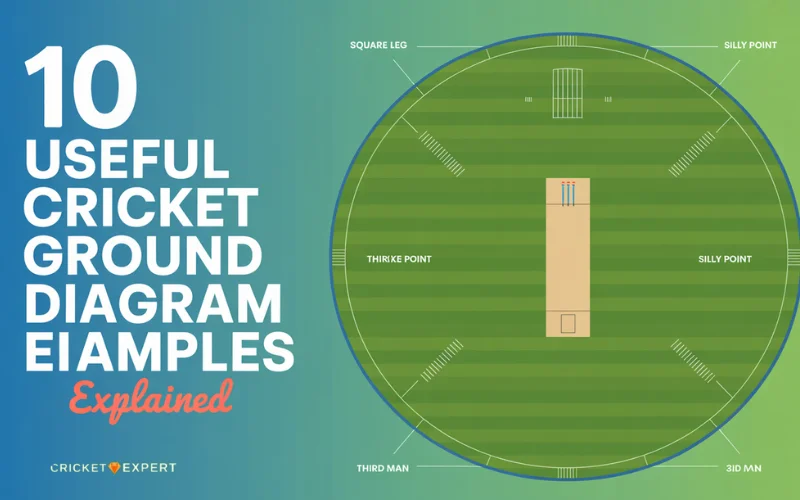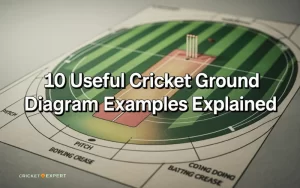Understanding a cricket ground diagram is essential for players, coaches, and fans. A cricket ground is not just an oval-shaped field but a carefully planned space with sections that have specific names and roles in the game. By studying cricket ground diagram examples, one best jersey design cricket can learn where bowlers deliver the ball, where fielders are positioned, and how batting strategies are formed. In this article, we will explore 10 useful cricket ground diagram examples explained in detail to make the game clearer and easier to follow.
Importance of a Cricket Ground
A cricket ground diagram helps in visualizing the field layout. It shows the pitch at the center, boundaries, and fielding zones. For beginners, it acts as a guide to understand field positions, while for advanced players, it becomes a tool for planning strategies. Coaches also use cricket ground diagrams to illustrate tactics and train teams effectively.
Example 1 The Basic Cricket Ground
The most basic cricket ground highlights the oval shape of the field with the pitch in the middle. It shows the boundary line, the 22-yard pitch, and two wickets placed at both ends. This type of diagram is usually the first step in learning about the cricket field. It helps players understand the central structure of the game.
Example 2 Pitch Centered Cricket Ground
A pitch-centered cricket ground focuses more on the 22-yard strip in the middle of the ground. It marks the stumps, creases, and bowling ends. This type of diagram is especially useful for bowlers and batsmen who need to study where the bowler will deliver the ball and how the batsman positions himself.
Example 3 Fielding Position Cricket Ground
Another popular cricket ground is the one that marks all standard fielding positions such as slip, gully, cover, mid-on, and fine leg. This diagram is critical for captains who need to set the field according to the type of bowler and batsman at play. Beginners also find this diagram helpful in memorizing cricket fielding names.
Example 4 Powerplay Zone Cricket Ground
In limited-overs cricket, the powerplay overs are crucial. A cricket ground diagram showing the powerplay zones marks the inner circle where only a limited number of fielders can stand. This helps teams plan aggressive batting strategies and defensive field placements. It is commonly used in T20 and ODI formats.
Example 5 Boundary Measurement Cricket Ground
This diagram highlights the boundary distance from the pitch in all directions. Since each stadium can have slightly different boundary measurements, a cricket ground diagram like this helps players know how far they need to hit for a four or six. Broadcasters also use this type of diagram to display exact measurements during matches.

Example 6 Left Handed Batsman Strategy Diagram
A unique cricket ground diagram is the one prepared specifically for left-handed batsmen. Since angles and shots differ compared to right-handers, captains and bowlers use this diagram to plan fielding positions. It shows common scoring areas for left-handers such as square leg or midwicket.
Example 7 Bowling Strategy Cricket Ground Diagram
Bowlers often use cricket ground diagrams to plan their deliveries. For example, a fast bowler may mark where he wants his slip cordon and gully, while a spinner may highlight close-in positions like silly point or short leg. Such diagrams help the bowler visualize his plan before bowling.
Example 8 Stadium Layout Cricket Ground Diagram
A stadium layout diagram is another form of cricket ground diagram that includes not only the field but also stands, pavilions, and dressing rooms. This type of diagram is often found in stadium blueprints or official guides. It gives fans and organizers a complete view of the venue structure.
Example 9 Training Drill Cricket Ground Diagram
Coaches use cricket ground diagrams for training purposes. They mark areas where players need to practice fielding drills, catching practice, or bowling spots. These diagrams are practical tools for organizing sessions and ensuring players understand where to position themselves during exercises.
Example 10 Modern Digital Cricket Ground Diagram
In recent years, technology has introduced digital cricket ground diagrams that are used in live broadcasts. These diagrams show ball tracking, wagon wheels, and shot charts. They are not just static diagrams but animated visuals that help audiences understand player performance. For example, they can show where a batsman has scored most of his runs on the field.
Benefits of Using Cricket Ground Diagrams
Using a cricket ground diagram offers several advantages. It helps new players learn about the game, assists captains in field placements, and makes strategies clear for the entire team. Fans also enjoy watching matches with diagrams because they make complex strategies easy to understand.
How Cricket Ground Diagrams Improve Coaching
In coaching, a cricket ground diagram becomes a visual learning tool. Instead of just talking about positions, a coach can point to the exact location on the diagram. This visual method improves memory retention among players and helps them execute strategies better on the field.
Learning Field Positions with a Diagram
For young cricketers, remembering all 30 or more fielding positions can be overwhelming. A cricket ground diagram simplifies this by giving a clear picture of where each position lies. Over time, players become more confident in recognizing and moving to their assigned spots.
Conclusion
A cricket ground diagram is much more than a drawing. It is a learning aid, a strategy planner, and an educational tool. The 10 examples explained above show how versatile these diagrams can be. From simple layouts of the pitch to advanced digital graphics, each type has its own purpose. Whether you are a beginner, a coach, or a professional player, studying cricket ground diagrams can improve your understanding of the game and enhance your performance.









